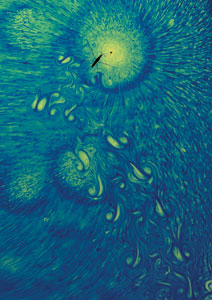






 |
 |

Hydrodynamic Propulsion of Water Striders
Caption:
In this image, a layer of water was sprinkled with the chemical Thymol Blue, which established the *Marangoni convection responsible for the evident fine-scale texture. The layer was lit from below, giving the flow a natural luminescence. The starburst in this image is associated with the relatively large particle of Thymol Blue evident at its center. The Thymol Blue reduces the local surface tension, thus prompting surface divergence that clears the surface of blue dye. Since the water striders are light-seeking, they are drawn to the starbursts.
In this National Science Foundation-supported project, dye studies were performed in order to determine what the propulsion mechanism is of the water strider (gerris remigis), a common water-walking insect. [See related images: Spider Vortices, Dipolar Vortices of a Water Strider, Robostrider Meets Water Strider, and Water Walkers.]
*Motions of the surface of a liquid are coupled with those of the subsurface fluid or fluids, so that movements of the liquid normally produce stresses in the surface and vice versa. The movement of the surface and of the entrained fluid(s) caused by surface tension gradients is called the Marangoni effect.
More about this Image
Water striders (gerris remigis) are common water walking insects approximately 1 cm long, that resides on the surface of ponds, rivers, and the open ocean. In the past, it was believed that water striders develop momentum using the tiny waves they generate as they flap their legs across the water's surface. This was because striders move so quickly that all you see is the waves. But baby water striders legs are not big enough to generate waves and therefore should be incapable of propelling themselves along the surface. So how are they able to move?
Enter Dr. John W.M. Bush, a mathematician from the Massachusetts Institute of Technology (MIT), and his team of researchers who--using high speed video and blue-dyed water--track the movement of water striders. Bush's high speed images and dye studies show that the water strider propels itself by driving its central pair of legs in a sculling motion. In order for it to move, it must transfer momentum to the underlying fluid. It was previously assumed that this transfer occurs exclusively through capillary waves excited by the leg stroke but Bush and his team found that, conversely, the strider transfers momentum to the fluid principally through dipolar vortices shed by its driving legs. The strider thus generates thrust by rowing, using its legs as oars, and the menisci beneath its driving legs as blades.
Dr. Bush received a grant from NSF's Fluid Dynamics and Hydraulics program (grant CTS 01-30465) for this project. An NSF graduate fellowship award supports David Hu, a graduate student working on the project.

(Preview Only)

|
| Credit: |
Courtesy John Bush, MIT |
| Year of Image: |
2003 |
|
Categories:
ENGINEERING / Chemical
INSECTS
Formats Available:
Restrictions:
No additional restrictions--beyond NSF's general restrictions--have been placed on this image. For a list of general restrictions that apply to this and all images in the NSF Image Library, see the section "Conditions".
|